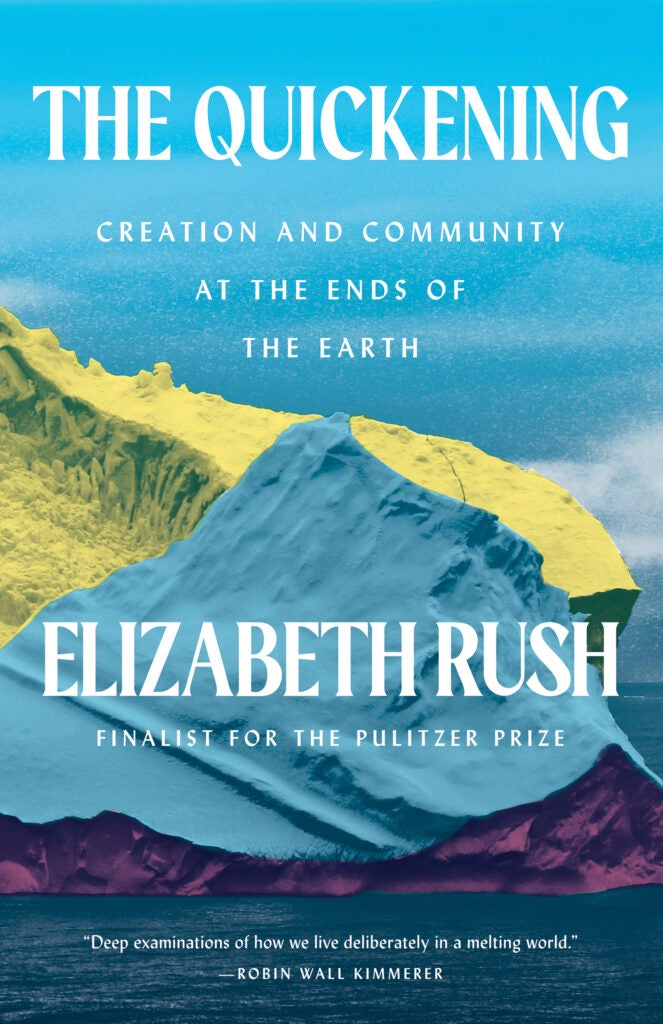What We’re Reading: “The Quickening: Creation and Community at the Ends of the Earth” by Elizabeth Rush
Rethinking the Stories We Tell about the 7th Continent
By Elyza Bruce CAS ‘25 & Common Home Editor

Book cover for The Quickening showing a neon mountain range.
Throughout history, stories have played a crucial role in shaping what society cares about and the visions of the future to which it aspires. As a result, it feels especially crucial for stories to be written about Antarctica — the most remote place in the world — for it is both symbolically and literally at the heart of the climate crisis. According to NASA data, between 2002 and 2023, the Antarctic ice sheet melted an average of 150 billion metric tons of ice per year, contributing greatly to global sea level rise.
Elizabeth Rush’s book, The Quickening: Creation and Community at the Ends of the Earth (2023), recounts her voyage alongside a team of 57 scientists and crewmembers to Antarctica to study the Thwaites Glacier, a region in Antarctica heretofore never traveled by humans, and which is rapidly deteriorating due to climate change.
The Quickening isn’t merely an adventure narrative following the exploits of scientists as they plunge into the unknown reaches of the seventh continent; Rush also deeply considers the social politics of Antarctic exploration. In particular, Rush unpacks the White, male-dominated perspectives that shape our cultural understanding of Antarctica, how this excludes the contribution of women and people of color, and what it would mean to give the Antarctic landscape the agency of a protagonist, rather than flattening it to a two-dimensional backdrop. Rush’s reimagination of the Antarctic landscape could have key implications for the way we understand the urgency of the climate crisis.
Before Rush set out on the months-long expedition, she combed through every book related to Anaratica she could find in the library. She soon discovered a pattern: the vast majority of “classic” tales about Antarctica feature White, male protagonists involved in the continent’s “discovery” at the turn of the century. As a result, the Antarctic becomes just another “blank spot” on the map and a backdrop for “well-educated white men [to] make displays of derring-do.”
Rush uses the term “Antarctic Masculinity” to describe the male-centric narratives and imagery surrounding Antarctic exploration. Beyond representation, “Antarctic Masculinity” is also present in the institutional frameworks that shape life on an Antarctic Voyage. For example, Rush points out the lack of uniforms to accommodate diverse body types beyond a traditionally masculine physique and the lack of preparation for the possibility of a pregnant body present during the expedition.
Another issue with this prevailing narrative surrounding the Antarctic that Rush aims to challenge is the limitation of who can even go to the Antarctic in the first place. Rush points out that no women or people of color are featured as protagonists in the stories from the “so-called Heroic Age of Antarctic Exploration” and their already limited contributions are relegated to that of service workers and captains’s wives. Because of this, Rush argues there is a “whole different lineage of stories missing from the Antarctic Archive” which she hopes to fill, in part, with her own narrative project.
In contrast to the hyper-individualistic tales of courageous explorers setting out to conquer the untouched regions of the planet, Rush bakes a sense of communalism into the structure of the book. The main narrative is interspersed with interview transcripts from various members of the crew — ranging from glaciologists and biochemists to electricians and the ship’s chef. In fact, Rush includes a “Cast of Characters” section in the front matter of the text, further cementing the crew’s status as active agents in the narrative. I think this experimental form of storytelling reflects the inherent communal nature of life on scientific expeditions, but also, more broadly, the communal experience of the climate crisis.
Rush invites readers to think of the Antarctic not as a cold, static place devoid of life, but as an active agent. Rush asks, “What if we were taught to see Antarctica not as a prize to be won but as an actor in its own right, an entity that shapes us just as much as we shape it?” As Rush describes the strange, Antarctic landscape, she tries to avoid using “language that denies agency to the birds and the sun and the land refusing them the pronouns that denote personhood.” Traditional narrative conventions require characters and plots to drive the story forward, leaving many stories about the Antarctic centered around the exploits of explorers. However, once Rush experienced the Antarctic as “an unfathomable sea that soon will transform into something solid, fused to a continent that carries traces of atmospheric history hundreds of thousands of years old,” she found these narrative conventions to be sorely lacking.
Rush highlights how in contrast to the Western scientific conception of glaciers, in Indigenous narratives of the Tlingit and Athapaskan people, “glaciers take action and respond to their surroundings” as they “give birth to seasons like summer and winter; at other times they swallow humans whole as a warning that others should act with greater humility.”
This shift in understanding about the nature of glaciers could have potentially crucial implications for the climate crisis. When we think of glaciers not as static, lifeless forms drifting on a distant region of the Earth, but as active, lively, constantly transforming agents in the Earth’s systems, it creates a greater sense of urgency surrounding their deterioration. This reimagination should not stop at ancient glaciers; rethinking all of the Earth’s ecosystems as active agents in their own rights will not only help us understand the true implications of climate change but also give us the tools to challenge the cultural practices that contribute to climate change in the first place.
